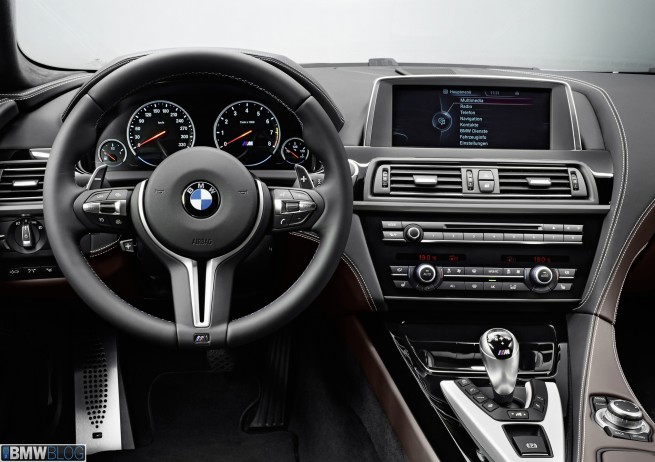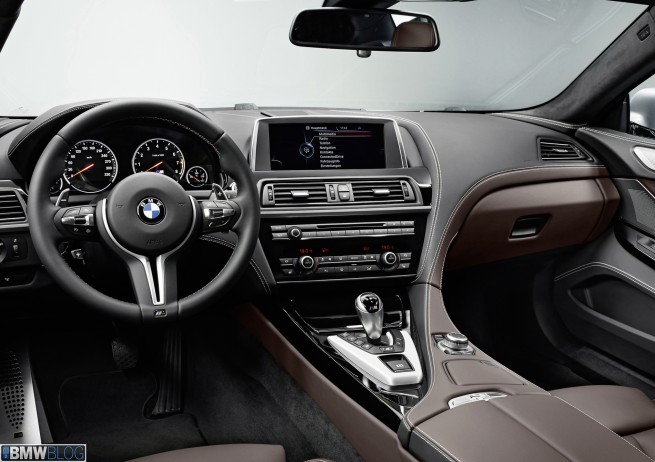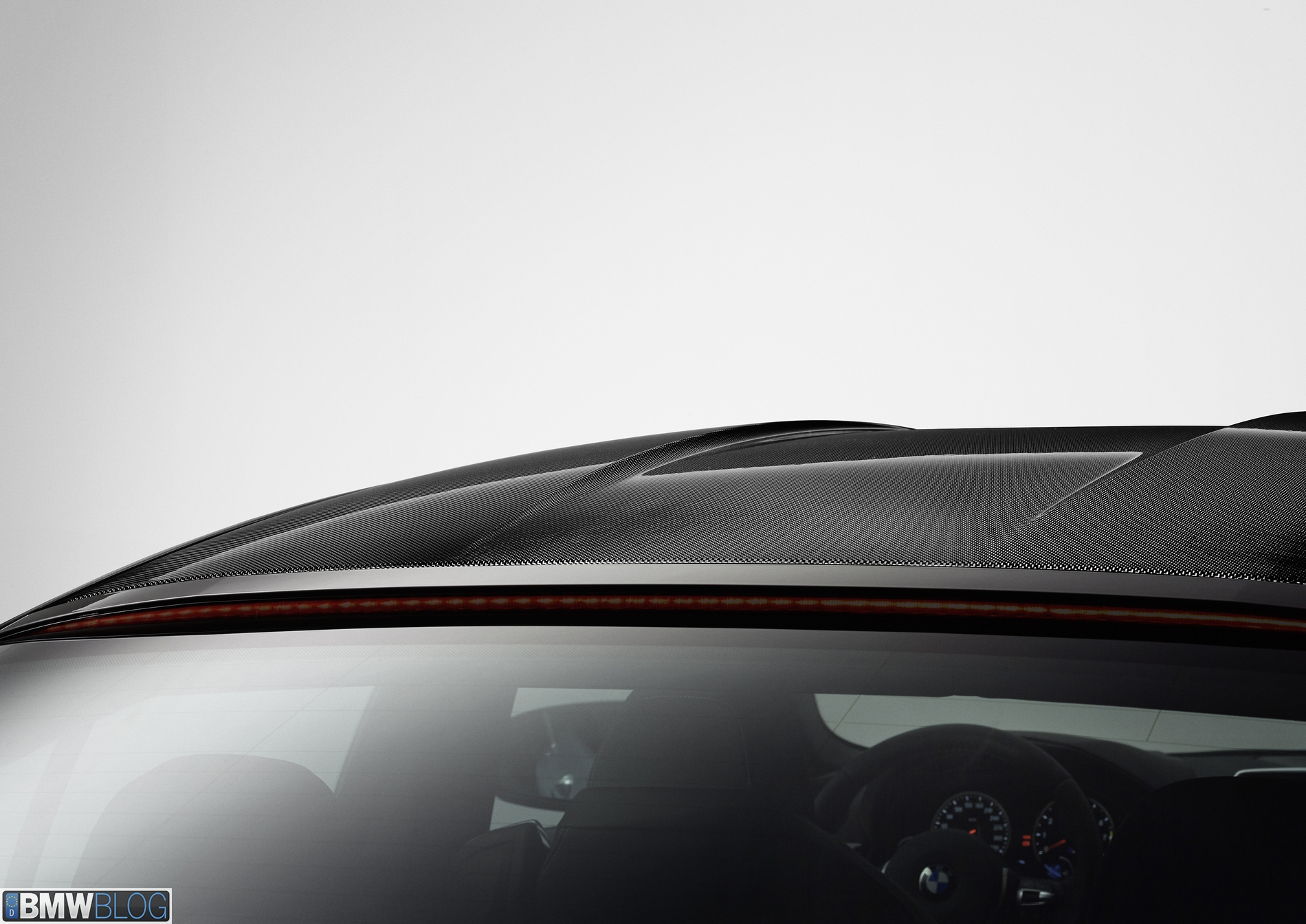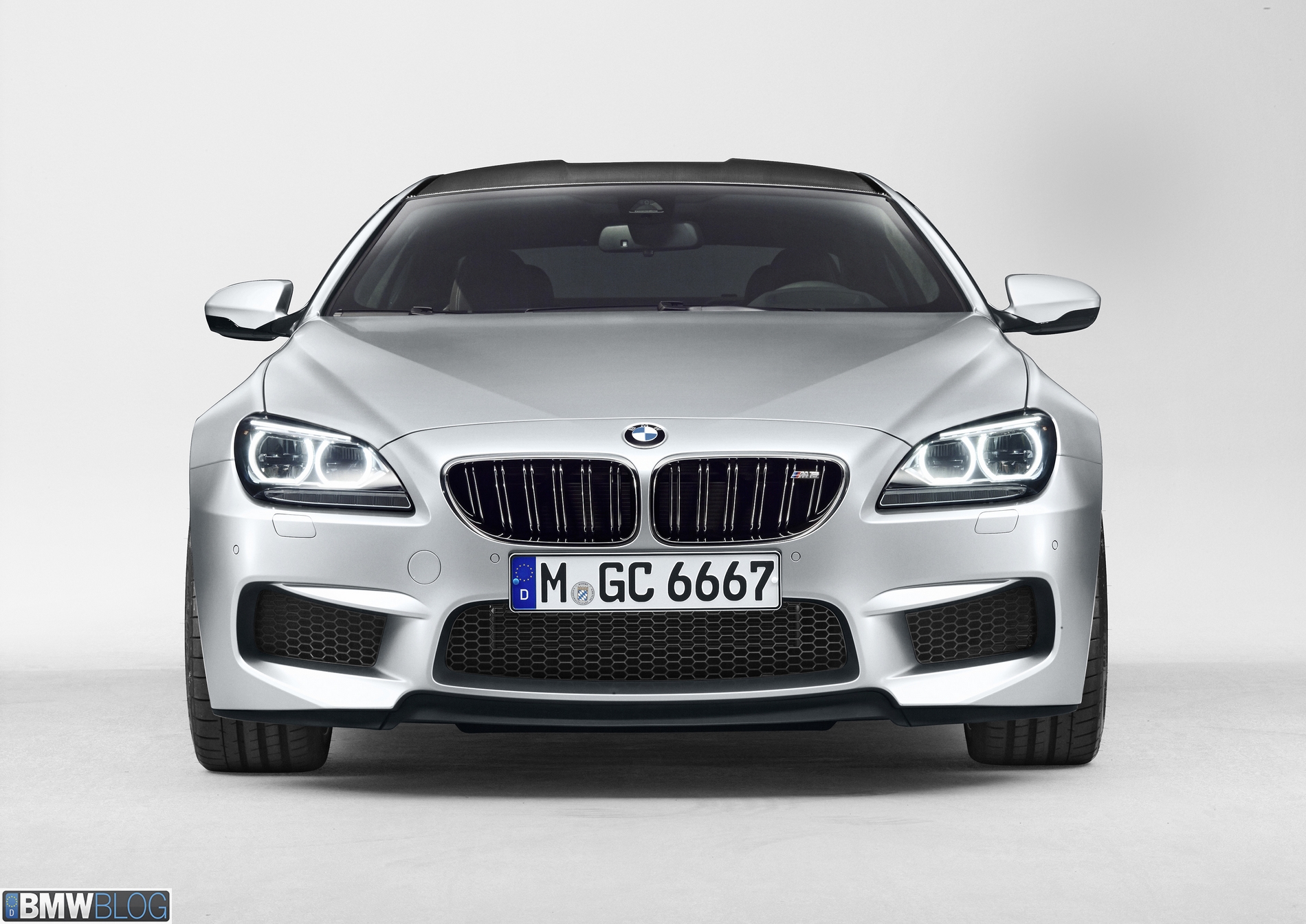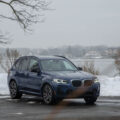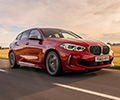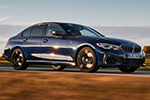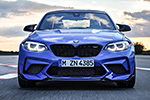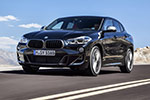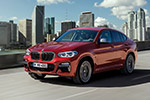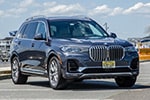In early summer 2013, the all-new BMW M6 Gran Coupe will join its famous BMW M5 Sedan and M6 Coupe siblings as what is perhaps the perfect combination of both. The BMW M6 Gran Coupe is an ultra-high performance, four-door Coupe design with stunning aesthetics, racebred technology, and the signature driving character of BMW M GmbH.
The recommended retail price Germany of the BMW M6 Gran Coupe is 128.800 €, including 19 % VAT. Market launch will be in May 2013.
The M6 Gran Coupe is made instantly unique among four-door vehicles by its bonded-in carbon fiber composite roof panel, similar to the one found on the M6 Coupe. Between the doors is a cabin of sensational coupe-like design and first-class materials. The M6 Gran Coupe’s control placement and – equally important – control feel are second to none. The four-plus-one seating arrangement allows the M6 Gran Coupe to carry four adults in luxury, and offers maximum seating capacity for five when needed.
The new M6 Gran Coupe features the most powerful engine ever fitted to an M production car, a 4.4-liter M TwinPower Turbo V-8 with 560 horsepower and an always-accessible 500 lb-ft of torque. With this endowment, the rear-wheel drive BMW M6 Gran Coupe practically rockets from 0-60mph in 4.1 seconds and reaches an electronically-limited top speed of 155mph in only a few seconds more.
The new BMW M6 Gran Coupe focuses the gargantuan muscle of its engine on the road through one of the most advanced drivetrains BMW has ever developed. The high-torque 7-speed M-Double Clutch Transmission (M-DCT) borrowed from the M5 and M6 Coupe sends power uninterrupted to the innovative Active M Differential, which in turn perfectly balances power between the rear wheels. This advanced drivetrain, combined with truly radical chassis and suspension revisions to the BMW 6 Series Gran Coupe on which the car is based, ensure that the M6 Gran Coupe’s substantial output is transferred to the ground
predictably and repeatedly.
The High-Revving M V-8 TwinPower Turbo Engine.
The engine of the all-new M6 Gran Coupe has the highest output ever generated by a BMW M car, and provides a meaningful balance between ultra-high performance and fuel consumption. The engine’s operating behavior is characterized by traditional M traits like immediate throttle response and linear power delivery. Additionally, thanks to turbocharging,
the engine features an unusually high and flat torque curve, sustaining peak torque from 1,500rpm – 5,750rpm. The engine produces about 10% more output than the M V10 engine which preceded it, and torque is up by over 30%.
To achieve the performance levels of the new M V-8, the engineers at BMW M GmbH started with the proven BMW M-developed 4.4-liter V-8 engine from the BMW X5 M and X6 M (internally known as the S63B44 engine) and further developed it for its duty in the latest M5 and M6 models. Internally designated S63B44Tü, this engine uses similar M Twin
Power technology combined with the reverse-flow V-8 layout. The result is that the highrevving V-8 engine lends a fresh intensity to the powerful M car experience. The S63Tü develops a peak output of 560 hp (412 kW) at 5,750 – 7,000 rpm (versus 555 hp at 6,000 rpm for the S63), while its maximum torque of 500 lb-ft (680 Nm) is on tap between 1,500 and 5,750 rpm (versus 500 lb-ft from 1,500 to 5650 rpm for the S63). The rev limiter intervenes at 7,200 rpm, up 200 rpm from the original S63 engine and now accessible in each gear until the top speed limiter intervenes. The rev band, which offers extreme
acceleration between peak torque and the availability of maximum horsepower, is therefore almost three times as wide as that of the V10 engine from the previous generation of M engines.
As in the M V-8 engine of the X5 M, the two twin-scroll turbochargers are placed (along with the catalytic converters) in the V-space between the two cylinder banks in a reverse-flow layout. This layout results in an unusually compact engine where the intake is moved outboard and the exhaust inboard – the opposite of traditional V-engines. The lengths of intake and exhaust tracts are thereby reduced and their diameters increased, reducing pressure losses – especially on the exhaust side. A further advantage of the layout is the short distance between the cylinders’ combustion chambers and the primary catalytic
converters; this leads to quicker warm-up of the catalysts after the engine is started and therefore lower start-up emissions.
The patented cross-bank exhaust manifold, first introduced in the S63 engine of the X5 M is also employed in the S63Tü, but with slightly larger tube sizes. This exhaust manifold is a special 8-into-4 setup that combines the exhaust from two cylinders (on opposite banks) that are 360° of crankshaft rotation apart from each other. Each of the eight runners is of identical length to ensure perfectly-regular timing of exhaust gas pulses. The acoustic sound of this engine arrangement is absolutely signature to BMW M.
Each of the four manifold outlets is fed into each of the four available scrolls of the two twinscroll turbochargers. The two scrolls of a twin-scroll turbo guide each exhaust pulse directly to the turbine without feedback or interference from the other scroll (that are fed by cylinders at other points in the combustion process). Additionally, dividing the gases into two smaller paths (scrolls) results in higher gas velocity than a single larger path. This enhances the turbocharger’s response, thereby reducing lag. The crossover manifold is configured so that the second scroll of the turbo is fed by two cylinders that are 180° out of phase with the first scroll. In this way each turbocharger receives distinct exhaust pulses every 180° of crankshaft rotation (from one of four cylinders). Furthermore, the two turbos receive exhaust pulses that are 90° offset from each other.
The result is that throttle response is sharpened and turbo lag is reduced to a minimum. The new engine also sports larger intake runners, larger air to liquid intercoolers and a tuned exhaust which results in the engine making power more quickly than previously possible. Finally, the S63Tü uses a maximum boost pressure of 1.5 bar (21.7 psi) versus 1.2 bar (17.4 psi) for the original S63 engine.
BMW’s efficient High Precision direct fuel injection also plays a major role in this engine’s combination of high performance and fuel efficiency. High Precision direct injection ensures an extremely precise supply of fuel to the combustion chambers. Injectors positioned centrally between the valves within immediate range of the spark plugs spray fuel into the combustion chambers with maximum pressure of 200 bar (nearly 3000 psi), providing smooth and clean combustion. Innovative solenoid valve injectors in the engine use multiple injections per combustion cycle to achieve an extremely precise mixture. The fuel also has a cooling effect on the combustion that allowed the M engineers to endow the engine with a high compression ratio of 10:1. This high compression ratio contributes to both performance and efficiency, while reducing exhaust emissions – and even has a positive effect on engine sound.
Throughout their histories, the hearts of the BMW M5 and M6 have been high-revving, high specific output engines fed by individual throttle bodies. The new engine introduces Valvetronic throttle-less intake system to a BMW M engine – effectively providing 16 individual throttles.
Valvetronic is BMW’s patented, fully variable intake valve control system that eliminates the need for conventional throttles. Engine power is instead controlled directly by varying the amount of lift of the intake valves. Pumping losses are minimized with this system, resulting in efficiency and torque improvements. Valvetronic has also sharpened the natural responsiveness of this engine compared to the V10 engine it replaces.
The M TwinPower technology of the new V-8 engine also includes BMW’s Double VANOS 1 infinitely-variable valve timing system which optimizes the engine’s efficiency and generates high torque at low engine revs. In addition, a volume-controlled oil pump and a range of other EfficientDynamics measures deliver an extra boost to efficiency. The new BMW M6 features both Brake Energy Regeneration and the Auto Start-Stop function, which automatically switches off the engine when the car comes to a stop. The instant power delivery and sustained thrust of the M TwinPower Turbo V-8 results in acceleration from 0– 60 mph in 4.1 seconds for the M6 Gran Coupe. Top speed is electronically limited to 155 mph (250 km/h).
7-speed M Double Clutch Transmission with Drivelogic
The new V8 engine M TwinPower Turbo engine is mated to a newly developed 7-speed double-clutch transmission designed to handle the high torque and high revving nature of the engine. The M-DCT with Drivelogic, developed especially for the new M5 and M6, has been tuned to match the performance characteristics of the engine with the M6 Gran Coupe chassis. It delivers exceptionally fast and clean gear changes in both Automatic mode (D) and Manual mode (S). No clutch pedal is required for manual gearshifts and the driver can stay on the accelerator during gear changes (conditions permitting). The driver uses the model-specific M gear selector to choose between D and S modes and to engage Reverse. Comfort is further enhanced by the new Low Speed Assistance function, which smoothes power delivery in stop-and-go traffic with a light touch of the accelerator pedal.
The shift lever offers a sequential shift pattern for the manual gearshift mode. Alternatively, the driver can also change gears using the shift paddles on the M leather steering wheel, complete with multifunction buttons. In typical M configuration, the driver pulls the righthand paddle to shift up and the left-hand paddle to shift down. The newest M steering wheel stands out with its smaller rim diameter and a design that borrows from the doublespoke design of the M light-alloy wheels.
M-DCT with Drivelogic offers three shift programs in both Automatic and Manual mode.
The driver selects his/her desired mode using the rocker switch positioned immediately below the shift lever on the center console. The D1 program is selected automatically when the engine is started, tailoring gear selection to deliver the most efficient possible driving style. D2 mode supports moderate cruising with gear changes carried out according to engine revs and load. And, to promote a sporty driving style laced with dynamic acceleration and deceleration, shift times in D3 mode are set up to delay gear changes until the engine has climbed higher up the rev range, and to downshift more aggressively when
slowing.
Drivers can also adapt the shift characteristics to their requirements in Manual mode. S1 mode generates comfortable and smooth gear changes. In S2, the gear changes are completed noticeably faster and accompanied by significant shift kick at higher revs. S3 is the one to choose for maximum driving dynamics; it enables even sportier gear changes and is required to initiate the Launch Control function. When the DSC stability control system is fully switched off, Launch Control allows the driver to achieve maximum acceleration from a standstill as permitted by surface conditions. During Launch Control acceleration, each gear upshift takes place automatically and at the optimum engine speed.
Active M Differential.
The Active M Differential in the new M6 Gran Coupe is an electronically controlled multiplate limited-slip differential programmed to optimize traction, stability and sporting character. The locking force within the differential is varied continuously between 0 and 100%.
The Active M Differential works with high precision and speed. Its control unit is connected with the Dynamic Stability Control (DSC) system via FlexRay high-speed data transfer technology and constantly cross-checks the data collected by its sensors with the feedback from DSC. It uses this information to calculate the locking force required to deliver optimum
traction and stability during both acceleration and deceleration. The data recorded by DSC sensors is provided to the Active M Differential whether the stability control system is in MDM mode or is switched completely off. The ABS system retains full functionality in all situations.
In addition to the data provided by DSC, the Active M Differential’s control unit also takes into account the position of the accelerator pedal, the rotational speed of the wheels and the car’s yaw rate. Every driving situation is therefore analyzed so that any loss of traction on one side of the car is identified at an early stage. The degree of axle lock is adjusted as required
within a fraction of a second, enabling wheel spin to be reduced on all surfaces, when the right and left rear wheel have widely differing friction coefficients and in tight corners. Optimizing traction in this way also provides unbeatable driving stability in challenging conditions and allows impressive acceleration out of corners. The Active M Differential can also unlock just as quickly to stabilize the car off-throttle.
M-Specific Chassis
Each component in the suspension and chassis of the new M6 Gran Coupe has been developed based on the extensive race expertise of BMW M engineers. The aluminum7 intensive integral rear axle subframe in the M6 Gran Coupe is rigidly bolted to the body to maximize body rigidity and handling precision. Reinforced chassis mountings at the front and rear axles ensure that dynamic forces are passed through to the body structure. Specially tuned axle kinematics and newly developed forged aluminum suspension components boasting high strength and low weight meet the requirements of everyday driving and the
specialized demands of track use. The result is that the BMW M6 Gran Coupe continues the BMW M tradition of engineering a chassis that is “faster than the engine”. As with every BMW M car, the engineers carried out the fine-tuning during extensive testing on the legendary Nürburgring Nordschleife circuit.
M Dynamic Damper Control (DDC) electronically controlled shock absorbers are standard on the new BMW M6 Gran Coupe. DDC uses electro-hydraulic damping force adjustment to provide a set-up suited to the driving situation and the wishes of the driver. The shock absorber settings can be adjusted at the touch of a button. In default Comfort mode, the dampers respond adaptively to the condition of the road surface and the driver’s style. Sport mode activates a noticeably stiffer damper set-up, while Sport Plus allows further stiffening of the suspension to achieve maximum longitudinal and lateral acceleration in ultra-dynamic driving situations.
At the touch of a button, the driver can also select from three settings for the M-specific Servotronic speed-sensitive hydraulic power steering. The default Comfort mode keeps steering forces reasonable when parking or maneuvering, but still provides the M brand’s hallmark direction-changing precision at higher speeds. Sport ensures the driver enjoys more intense feedback across all speed ranges. Sports Plus is the lowest level of steering boost that can be selected.
The new BMW M6 Gran Coupe also uses BMW’s most advanced Dynamic Stability Control (DSC) and Anti-lock Braking System (ABS) that includes Cornering Brake Control (CBC), Dynamic Brake Control (DBC), Brake Assistant, Brake Fade Compensation function, a Brake Drying function and Start-off Assistant. The DSC system has three levels of operation. The
default is “On” which provides the greatest level of stability and traction control. M Dynamic Mode (MDM) can be activated to override the default setting by pressing the DSC button on the center console. This mode allows for very spirited driving – as on a race track – while still providing a safety net, by raising the intervention thresholds of DSC. “DSC Off” mode can also be activated with a long-push of the DSC button for complete deactivation of the system.
Choice of High-Performance M Brake Systems.
The standard high-performance braking system of the new BMW M6 Gran Coupe guarantees outstanding stopping power matching the overall performance of the car. The well-known BMW M compound rotors have been further improved for the new M5 and M6 family. These rotors thermally separate the central hub (constructed of aluminum) and the vented / cross drilled cast iron rotor discs. As a result, the rotors are free to expand and contract without warping. The diameter of the brake rotors is 15.7 inches (400 mm) at the front and 15.6 inches (396 mm) at the rear. The six-piston fixed calipers are radially bolted to the pivot bearing and are painted blue metallic complete with the M logo. Together, the M brake system has been tested to provide exceptional performance and modulation, fade resistance, and pedal feel.
The new BMW M5 and M6 family will be the first cars in the history of BMW M to be offered with optional M Carbon-Ceramic brakes, which become available with Spring 2013 production. These new brakes are without parallel and take the cars’ stopping power to a new level – especially on the race track. The brake rotors measure 16.1 inches (410 mm) in diameter at the front and 15.6 inches (396 mm) at the rear. Made from a carbon-fiber ceramic composite, the rotors boast even greater resistance to heat combined with significantly reduced rotating masses. The M Carbon-Ceramic brakes are 42.8 lb (19.4 kg)
lighter than the standard brakes, yet the innovative material also displays exceptional resistance to wear, and the operating life of the rotors is several times that of conventional equivalents. The optional M Carbon-Ceramic system also sees six-piston fixed radial calipers at the front teamed with single-piston floating calipers at the rear. The M Carbon-Ceramic system can be easily identified through the wheels by the special gold-colored calipers.
The M6 Gran Coupe features a unique wheel and tire combination with 20-inch M6 Gran Coupe-specific double-spoke forged light alloy wheels fitted with giant ultra-high performance summer tires, front and rear.
The Design: An M Showstopper.
Hallmark M design features are always influenced directly by technical considerations – such as cooling air requirements, chassis geometry, weight-and-balance, and aerodynamics. This form-follows-function philosophy opens a design window through which to see the performance capability of the BMW M6 Gran Coupe. The front of the car is dominated by its large air intakes, optional Adaptive LED Headlights and an M kidney grille designed especially for this model. From the side, the M four-door Coupe is clearly distinguishable from the BMW M6 Coupe thanks to its rear doors and 113-millimeter (4.45”) longer wheelbase. The low roofline flowing smoothly into the rear, the shoulder line – which takes in the door openers – and side windows extending well into the C-pillars accentuate the dynamically stretched silhouette.
Prominently flared wheel arches draw the eye to a track width specific to the BMW M6 Gran Coupe. The characteristic M gills, aerodynamically optimized exterior mirrors, standard BMW Individual High-gloss Shadow Line package and exclusive 20-inch M light- alloy wheels in double-spoke design underline the car’s distinctive appearance, as does another M signature – twin exhaust tailpipes positioned on the outer edges of the rear apron. Also integrated into the rear apron, and charged with the task of optimizing the exit of airflow from the car’s underbody, is a diffuser made of carbon fiber composite.
Carbon fiber composite, an extremely lightweight, impressively strong high-tech material is used in the construction of the car’s roof panel as well. Here, the visible carbon structure provides an eye-catching feature, as does a dynamic recess in the center of the roof. This recess is referenced stylistically inside the car, the anthracite-colored Alcantara headliner gaining a central section in leather.
Emulating the harmonious blend of athletic prowess and elegance embodied by the exterior design, the distinctive M cockpit fuses sports car style with generous levels of space and a luxurious ambience. The driver and front passenger will enjoy M sport seats with integral seatbelts. And the BMW M6 Gran Coupe’s standard specification also includes Merino Extended leather upholstery. The rear compartment offers three seats, the backrests of which can split and fold down in a ratio of 40 / 60 to increase luggage flexibility.
M-specific cockpit design: flawless car control, made-to-measure luxury.
The interior of the new BMW M6 Gran Coupe brings together the incomparable combination of the driver-oriented cockpit design of a sports car with the spaciousness and luxurious feel of a premium automobile. Merino Extended leather upholstery, door sills with “M6” lettering, an M driver’s footrest, exclusive carbon fiber interior trim and the headliner in Anthracite Alcantara and Leather are all standard equipment, as is the iDrive control system with a 10.2-inch Control Display. This screen is centrally positioned and like the controls in the central section of the instrument panel, slightly oriented towards the driver.
M Multifunction sport seats offer the driver and front passenger optimum lateral support while cornering, but also a high level of comfort over long distances. The lightweight seats with integrated belt system have an M-specific design headlined by extremely prominent cushion and backrest bolsters, head restraints integrated into the backrests, eye-catching stitching emphasizing the segments of the seats, and an M logo embossed into the shoulder area. The M Multifunction sport seats have electric height, fore/aft, side bolster and backrest angle adjustment, and also come with pneumatically adjustable lumbar support, a memory function and a manually adjustable thigh support. The M Multifunction sport seats are fitted with active head restraints to reduce the risk of whiplash injury in a rear-end impact.
The M instrument cluster with black-panel technology includes classic circular instruments in traditional BMW M car style, with red needles and white illumination, as well as model- specific displays and the M logo on the rev counter. The shift program currently selected and gear engaged are shown in the center of the instrument cluster. Feedback from the drive and chassis settings are also displayed in the instrument cluster under the tachometer.
Sports Car Cockpit – Custom Tailored M Drive Buttons
On the left-hand steering wheel spoke, the driver has two M Drive buttons which can be used to call up a pre-configured setup for the car. For example, the driver can save a sporty configuration on the “M1” button and a track focused setup (with all driver aids shut off) on the “M2” button. The set-up selected will remain activated until it is either cancelled by pressing the button again or the driver switches to another M Drive setting. Once the system has been switched off – as when the engine is started – it reverts back to the default configuration.
The M Drive system in the new BMW M6 Gran Coupe allows the driver to adjust no fewer than six parameters: the engine management, the response of the Servotronic steering system, the M-DCT shift program, the DSC mode, the responses of DDC and the information in the Head-Up Display. The desired settings can be configured in any combination via the iDrive menu or by using the M Drive select buttons on the center console to set the configuration followed by pressing and holding one of the two M Drive buttons for a few seconds (until the configuration is stored). For safety reasons, a setup involving setting MDM mode or “DSC Off” requires confirmation from the driver – by pressing the M Drive button again – before it can be activated. The setup configuration selected is shown by a “M1” or “M2” symbol displayed in the instrument cluster.
M Head-Up Display.
The M Drive configuration also includes the information shown on the optional M Head-Up Display and projects important information onto the windshield directly in the driver’s field of vision. A full spectrum of colors is used to display graphics and symbols and the all-color capability means road sign symbols can be reproduced very realistically. In addition to a digital speed read-out, the M-specific version of the Head-Up Display also shows the gear currently engaged and a color rev counter symbol, complete with Shift Lights.
Developed on the Nordschleife- as with every car ever engineered by BMW M
BMW has been testing on the legendary Nürburgring Nordschleife since the 1960s. Every vehicle developed by BMW M since its establishment in 1972 has had to demonstrate its capabilities on the grueling 14-mile circuit before it was deemed ready.
In the early years BMW conducted tests out of rented facilities. BMW Motorsport also rented facilities for many years in order to prepare for race activities like the 24h enduro at the ’Ring.
So dedicated was the company to fully integrating the Nürburgring into its testing regimen that, in 1991, BMW became the first manufacturer to establish a permanent testing facility on site. Between 2003 and 2008 the test facility was re-built and enlarged without interrupting ongoing test activities. This dedication can be felt from behind the wheel of every product created by BMW M. The new BMW M6 Gran Coupe is the latest model to demonstrate the results of this dedication.
The new BMW M6 Gran Coupe will reach US Authorized BMW Center showrooms in early Summer, 2013. US Pricing, final technical specifications, EPA fuel efficiency estimates, as well as standard and optional equipment for will be announced closer to the on-sale date.





